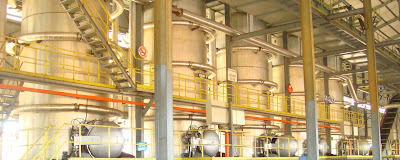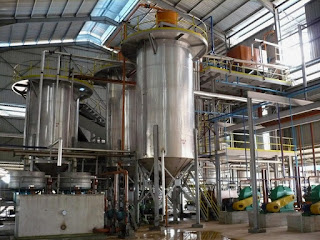 |
| Palm Oil Mill |
Introduction of the Palm Oil Milling Process
Fresh Fruit Bunch
Palm oil (CPO, Crude Palm Oil) is extracted from FFB (Fresh Fruit Bunch) by mechanical process, where a mill commonly handles 45 to 100 mt per hour of FFB. The modern palm oil mill of today is based predominantly on concepts developed in the early 50s. An average size FFB weighs about 20-30 kg and contains 1500-2000 fruitlets.
The FFBs (Fresh Fruit Bunches) are harvested according to harvesting cycles, and delivered to the mills on the same day. The quality of crude palm oil is dependent on the care taken after harvesting, particularly on the handling of the FFBs.
 |
| Palm Oil Milling Process |
A palm oil mill produces crude palm oil and kernels, as primary products and biomass as secondary product. The capacity of mills varies between 45 - 100 tons FFB/hour. A typical mill has many operation units as shown in picture. This comprises of sterilization, stripping, digestion and pressing, clarification, purification, drying and storage.
For the kernel line, there are steps such as nut/fibre separation, nut conditioning and cracking, cracked mixture separation, and kernel drying, storage. The dried kernels are often sold to palm kernel crushers for extraction of crude palm kernel oil. In some integrated plants, kernel crushing facilities exist side by side at the same complex.
See also : The Oil Palm and its Fruit
 |
| FFB Sterilizer |
Sterilisation
This first step in the process is crucial to the final oil quality as well as the strippability of fruits. Sterilization inactivates the lipases in the fruits, and prevents build-up of Free Fatty Acids (FFA). In addition, steam sterilization of the FFBs facilitates fruits being stripped from the bunches. It also softens the fruit Mesocarp for digestion and release of oil, and conditioning of nuts to minimize kernel breakage. Air is removed from the sterilizer by sweeping in steam in single-peak, double-peak or triple-peak cycles.
In general, bunches are cooked using steam at 40 psig. in horizontal cylindrical autoclaves for 60-90 minutes. The length of the sterilizer is dependent on the number of cages required for operation of the mill. Each cage can hold 2.5 to 10 tons of FFBs. Steam consumption varies from 140 kg/ton FFB for a single-peak cycle to 224 kg/ton FFB for a triple – peak cycle. Inadequate sterilization affects the subsequent milling processing stages adversely.
In recent years, new technology on sterilization saw the introduction of continuous sterilizers. Sivasothy’s (2006) continuous sterilizer showed improved fruit strippability, even with usage of low pressure steam or atmospheric steam. The new system consists of conveyor belt taking crushed FFBs into the continuous sterilizer, where the fruits are sterilized and subsequently discharged. This reduces much of the machinery associated with conventional sterilizers. In addition, there are cost savings in terms of manpower requirements, and maintenance.
Vertical sterilizers are also available, which are much cleaner and easier to operate than conventional sterilizers.
Another type of sterilizer technology, the Tilting sterilizer also eliminates much of the machinery associated with conventional sterilizers. The technology is the latest design that offers improved milling efficiency, and reduced labour and maintenance cost.
Read this article : Social and Environmental Impact of Palm Oil
 |
| Thresher |
Stripping
Stripping or threshing involves separating the sterilized fruits from the bunch stalks. Sterilized FFBs are fed into a drum stripper and the drum is rotated, causing the fruits to be detached from the bunch. The bunch stalks are removed as they do not contain any oil. It is important to ensure that oil loss in the bunch stalk is kept to a minimum. The stalks are often disposed by incineration, giving ash as potash fertilizer, and fuel for boilers. Others are transported to the plantations for use as fertilizers in mulching near the palms.
The total oil loss absorbed on the stalks depends on the sterilizing conditions and partly on the way the stripper is operated. Prolonged sterilization will increase oil loss in stalks. Irregular feeding of the stripper may also result in increase of oil loss in stalks. Stalks which have fruits still attached on them are called hard bunches, and have to be recycled back to sterilizers for further cooking. Hard bunches are detected by visible inspection.
 |
| Digester |
Digestion and Pressing
After stripping, the fruits are moved into a Digester, where the fruits are reheated to loosen the Pericarp. The steam heated vessels have rotating shafts to which are attached stirring arms. The fruits are rotated about, causing the loosening of the pericarps from the nuts.
The Digester is kept full and as the digested fruit is drawn out, freshly stripped fruits are brought in. The fruits are passed into a screw press, where the mixture of oil, water, press cake or fibre and nuts are discharged. Improvements in press designs have allowed fruits to undergo single or multiple pressing. Second stage pressing on the press cake fibres enables more oil to be extracted.
 |
| Oil Clarification Tank |
Clarification
A mixture of oil, water, solids from the bunch fibres is delivered from the press to a clarification tank. In the conventional process, separation of the oil from the rest of the liquor is achieved by setting tanks based on gravity. The mixture containing the crude oil is diluted with hot water to reduce its viscosity. A vibrating screen helps remove some of the solids.
The oil mixture is heated to 85-90◦C and allowed to separate in the clarification tank. A settling time of 1-3 h. is acceptable. Oil from the top is skimmed off and purified in the centrifuge prior to drying in vacuum dryer. The final crude palm oil is then cooled and stored. The lower layer from the clarification tank is sent to the centrifugal separator where the remaining oil is recovered. The oil is dried in vacuum dryers, cooled and sent to storage tanks.
Decanters
Decanters are also used in some mills as an alternative to separating the suspended solids from crude palm oil in a clarification tank. Various design of decanters are available. Their usage is however, hampered by higher maintenance costs from the wear and tear. An advantage to the use is the reduction in palm oil mill effluent. Sulong and Tan (1996) had proposed a membrane filter press for oil and solids recovery. The cake is discharged as solid waste for fertilizer production or animal feed, while the oil is recovered.
 |
| Decanter |
Oil Losses during Processing
Oil losses in mills vary from mill to mill, and much attention is given to the control of oil loss. The main oil loss are from sterilizer condensate, empty bunches, fruit loss in Unstrapped Bunches (USB), press cake fibre, nuts and sludge. Over-ripe bunches will lose more oil during sterilization. To minimize this, shorter sterilizer cycles are used, or better control of bunch ripeness and quality will help ensure less wastage.
A typical oil loss in sterilizer is estimated to be 0.1% to FFB. Oils recovered from sterilizer condensate should be used as technical oils, as they often contain higher iron content and would reduce oil stability if mixed with the crude production oil.
Kernel Production
The press cake from the digester is fed to a vertical column (Depericarper) where air is channeled to lift the fibre, thus separating the fibre from the nuts. The nuts are passed to a polishing drum at the bottom of the depericarper, where pieces of stalks are removed. A nutcracker cracks the nuts after the conditioning and drying process.
A ripple mill is also used instead of nut cracker. The mixture of cracked nuts and shells are separated via a winnowing system, followed by a hydrocyclone or a clay bath. A hydrocyclone uses centrifugal force to separate the kernel from the shell using water. The clay bath principle works on the specific gravity of kernel of 1.07 and the shell of 1.17. The kernels will float while the shells sink in a clay bath mixture of SG 1.12. The kernels are then dried in hot air silos to moisture content of less than 7%. About 0.4 mt of kernels are produced with every mt of CPO (Crude Palm Oil).
Read this article : Palm Kernel and Palm Kernel Oil
 |
| Nut Polishing Drum |
Biomass
The amount of solid palm oil waste available from a mill can be substantial. This consists of EFB (Empty Fruit Bunches), palm kernel shell, mesocarp fibres, and possibly solids from decanters. In most cases, this biomass especially, the EFB, palm kernel shell and mesocarp fibres are used as fuel in the mill, generating enough electricity for running the mill.
Besides usage as fuel, the biomass together with fronds and trunks can be left in the fields as fertilizers. EFBs can also be combined with Polyurethane Ester (PU) to prepare medium density fibreboard, giving higher impact strength and better water resistance.
Read this article : Chemical Composition of Palm Oil
 |
| Palm Oil Mill Effluent |
Treatment of Raw Palm Oil Mill Effluent (POME)
A palm oil mill produces an average of 0.65 tonne of raw POME (Palm Oil Mill Effluent) from every ton of FFB processed. POME is the main cause of environmental pollution due to its high acidity, high BOD (Biological Demand) and COD (Chemical Oxygen Demand). Conventionally, anaerobic digestions in ponding systems or aerobic treatments are able to bring the BOD levels to below 100 mg L-1. Open steel tank digesters are used for tapping the biogas for power consumption.
In Malaysia, certain areas have more stringent requirements (BOD of less than 20 mg L-1. Tertiary systems have been developed as new systems to provide effluent treatment in a more sustainable manner, as well as achieving the standards required by regulatory bodies. These include biological sequencing batch reactors, bio-filtration systems, systems with high aeration rates, activated sludge plants with aerobic reactors, bio-flow polishing plants, as well as membrane Bioreactors.
More palm oil plantations are investing into these technologies to harvest the biogas for fuel, and re-use other biomass materials for fertilizers, bio-composite materials, etc.
You may also like this Articles :
Palm Oil Production and The Nutrition for Health
Oil Palm Plantation and Production in Malaysia
About Palm Oil
Roundtable on Sustainable Palm Oil / RSPO
No comments:
Post a Comment